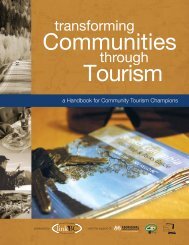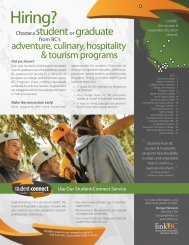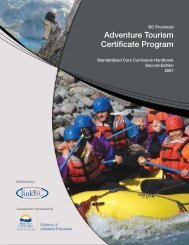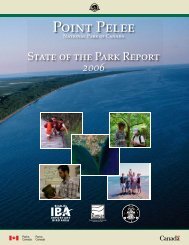Cultural Heritage Tourism Handbook - LinkBC
Cultural Heritage Tourism Handbook - LinkBC
Cultural Heritage Tourism Handbook - LinkBC
- No tags were found...
Create successful ePaper yourself
Turn your PDF publications into a flip-book with our unique Google optimized e-Paper software.
Nova Scotia ShowcaseA Region-Wide, Community-Centred FestivalThe Festival takes place in communities all over Cape BretonIsland—ranging from urban Sydney, with a population of30,000, to small remote locations, First Nations and Acadiancommunities. Venues vary from a 2,000-seat arena to 120-seat community halls, and include churches, schools, halls,theatres and cultural centres. It now attracts visitors toexperience over 300 artists at more than 40 shows, 200community cultural events and a nightly Festival Club.The festival has extended the tourism season by two monthsin Cape Breton by encouraging attendees to move aroundthe island and enjoy the fall foliage while seeking outevents. Celtic Colours does an annual survey to measurehow much the audience spends during the festival. In 2010that number was $6.2 million, spread widely throughoutthe island. Enterprise Cape Breton Corporation calculatedthat the overall economic impact to the region is now animpressive $15 million.Authenticity and Visitor Service are KeyThe Festival appeals to travellers because it is truly authentic,reflecting the real culture and flavour of the region. CelticColours’ staff works with communities around the island toprovide the best possible visitor experience, and to buildlocal acceptance. Plans are realistic, based on the talents ofthe community volunteers, as well as specific attractions,accommodations and sources of support and enthusiasm.For example, a community without a restaurant will host acommunity-made dinner on the night of their concert. InMabou, with many fine fiddlers and step-dancers to drawCelebrating Identity through theCeltic Colours International FestivalThe Right Time of YearEach year, when the changing leaves of a Nova Scotia autumn add a splashof colour to the scenic Cape Breton Island landscape, a group of dedicatedindividuals work to coordinate the successful Celtic Colours InternationalFestival. This event has grown over the last 15 years—and celebrates anddevelops the region’s living Celtic culture and hospitality—while buildingcultural and economic relationships across Cape Breton and beyond. It‘sa draw for international artists, which increases visitor appeal, and helpsbuilds strong global ties between artists.upon, they offer workshops in traditional music to all agesand abilities.This authenticity has paid off in high visitor satisfaction. Ina recent survey of almost 1,000 festival-goers, 96% ratedCape Breton hospitality as excellent or good, and 91%rated the festival offerings and arrangements in the samehigh categories.Providing Benefits to LocalsFestival staff are committed to ensuring economic benefits arespread throughout the region. Well over 300 of the performers arelocal, and performer’s fees of $200,000 are distributed annually. An“Artist in Residence” program engages a local and a visiting artistto take on a special role during the festival, and the Celtic Coloursoff-season school program presents performances to 8,500 students.The festival reports these benefits for communities:• <strong>Tourism</strong> businesses are extending their season of operation.• Communities are gaining confidence through working with festivalstaff on cultural events, and are planning events year-round.• Community groups are upgrading local venues to meet festivalstandards.• Local artists are now working full-time and touring abroad becauseof festival exposure.• Young people are gaining job experience, and benefitting fromthe training provided by the festival.• New marketing partnerships are being formed.Celtic Colours partners closely with Gaelic cultural organizationsby providing them with artists and promoting their events.Recently the festival joined with other signatureGaelic attractions on Cape Breton Island (the CelticMusic Interpretive Centre, Highland Village Museum,and Gaelic College of Celtic Arts & Crafts) to form theCeltic Heart of North America marketing cooperativewww.celticheart.ca, thus extending the reach of all partners.Measuring SuccessCeltic Colours has collected very detailed data on its audience,and the resulting economic impact. For example,according to National Car Rental statistics, the averagecontract for a Celtic Colours tourist was nine days whilethe average stay of other tourists throughout the seasonwas 3.7 days. A report generated by Enterprise CapeBreton stated that 103 jobs and 34 spin-off jobs are createdbecause of the festival.2009 data shows 18,400 tickets were sold to 44 concertsand over 13,000 people attended almost 292 events. 58%of the audience travelled to the region for the festival (22% frommainland Nova Scotia, 20% from other Canadian regions, 13% fromthe US and 3% from as many as 20 other countries).RecognitionLearn more: www.celtic-colours.comThis cultural/heritage tourism initiative is getting noticed: afterreceiving other awards over the years, in 2011 Celtic ColoursInternational Festival was named the winner of the National <strong>Cultural</strong><strong>Tourism</strong> Award, offered through the <strong>Tourism</strong> Industry Associationof Canada.“It is a great honour to be recognized on a national level,” said ArtisticDirector Joella Foulds. “It is a testament to the attraction peoplehave to our unique culture. Our focus has always been to presentan authentic cultural experience within a world-class framework.”Robert Sampson, Chair of the Festival Society commented: “CapeBreton’s unique Celtic heritage, its living culture and its special charmis what draws visitors. We enable our audience to get to know theculture in an intimate way by providing an authentic experience.Through this annual festival and its year-round influence, we havecreated a destination of choice for the Celtic cultural tourist.”With this foundational understanding in place, you are ready for the next step. You’ve moved beyond the basics of preparing your community’speople, places and activities, to understanding and building on your cultural character. There are a few final considerations thatwill help move your strategy forward.70 71










